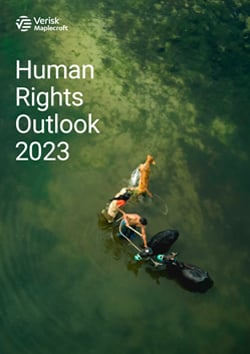Adding the E into HRDD – European legislators target interconnected risks
Human Rights Outlook 2023
by Dr. James Sinclair,
The fabric of the global risk landscape has become so interwoven that issues such as climate change, human rights and political risk can no longer be viewed as individual threads. We’ve been thinking about risk in this way for over a decade, but the interconnectedness of these issues has now moved firmly into the sights of regulators, who are increasingly demanding that companies take a more holistic and systematic approach to the way they assess, manage, remediate and report on social and environmental risk.
The first signs of this shift have already taken place. New laws, such as the German Supply Chain Due Diligence Act (LkSG) and the EU’s Directive on Corporate Sustainability Due Diligence (CSDD), require organisations with global footprints to expand their human rights due diligence (HRDD) efforts to also encompass environmental factors (HREDD). Creating a new HREDD risk assessment framework creates critical challenges for multinationals that have traditionally disaggregated human rights and environmental issues. We explore what this means in practice and lay out how companies can get ahead of new and emerging legislation.
The HREDD data challenge
One of the primary challenges of implementing a successful HREDD programme is the alignment of datasets, due diligence methodologies and reporting practices. This is because historically, human rights and environmental risks have been assessed using different methodological frameworks.
Data collected in the process of undertaking human rights due diligence tend to have three qualities:
- They are largely qualitative in nature, often gathered via interviews orsurveys, even if they are subsequently assigned scores for the purposeof analysis
- They tend to involve harms that manifest themselves immediately or inthe short term, such as workers’ rights violations or infringements on therights of indigenous people or other vulnerable groups
- The harms observed are often localised in nature, impacting individuals orcommunity groups rather than cities, countries or continents as a whole
By contrast, environmental compliance data are inherently quantitative in nature. This can include short term metrics that are in a company’s power to influence, such as litres of water used or tonnes of Co2 emitted. It can also refer to more consequential factors, including exposure to the physical impacts of climate change, which will manifest over a longer time horizon and a much wider geographical area.
The key word here is ‘exposure.’ One of the first steps towards compliance with new and emerging supply chain legislation, as well as frameworks such as the Task Force on Climate-Related Financial Disclosures (TCFD), is the identification of risk exposures. But as we’ve just highlighted, finding a common language that bridges both the human rights and environmental disciplines is a challenge for many organisations.
This is where geospatial risk data can help. A comparative dataset that measures both human rights and environmental risks at the global level enables companies with international footprints to quickly identify their most salient risks across their operations, supply chains and investments. Moreover, when that dataset includes a consistent scoring framework for both sets of issues it allows companies to think and talk about these risks in the same way. Resources can then be more effectively targeted when mitigating or remedying human rights or environmental harms.
How the law is adopting HREDD
Turning to the granular detail, the new German Supply Chain Due Diligence Act (LkSG) is a concrete example of a law that seeks to incorporate human rights and environmental due diligence within a single legal instrument. The LkSG makes reference to certain environmental actions (water, air, soil, noise pollution) that could result in harms to the health of people through impacts such as food production and clean water availability. This underscores the causal link that often exists between environmental harms and human rights violations.
The law also includes three standalone environmental references covering persistent organic pollutants, mercury use and hazardous waste, and provides a set of requirements to meet the provisions of the various international conventions governing these specific areas.
Taken together these measures represent a smart, targeted approach to the integration of a few key environmental issues into an existing human rights framework and they should help companies navigate these increasingly interconnected risks.
However, they are a long way from a singular, overarching, integrated approach to HREDD. There is nothing in the LkSG on biodiversity loss or deforestation or the destruction of the marine environment, for example, and the law otherwise sticks closely to a UNGP inspired human rights due diligence framework. It is true that the OECD Guidelines for Multinational Enterprises and the related Due Diligence Guidance on Responsible Business Conduct have incorporated environmental elements for some time, but these are non-binding (if influential) documents.
But this isn’t to say that this will be the case for all future HREDD related legislation. The forthcoming EU Corporate Sustainability Due Diligence Directive (CSDD) is likely to come into force in 2025/6 and is also seeking to integrate both human rights and environmental due diligence for larger companies operating in or through the EU and may yet involve more comprehensive integration of the two elements.
One way in which companies can navigate these complexities is through the creation of singular ‘sustainability departments’ to replace distinct human rights and environmental units. There could be merit in this approach if the intention is to more efficiently share overlapping data and resources (for example on site visits or legal/compliance capacity). It should also speed up the reporting process, for example in relation to the Corporate Sustainability Reporting Directive (CSRD).
However, companies need to ensure that both human rights and environmental elements are properly considered. There is currently a primary focus on climate and natural capital issues among many corporates and investors, not least because of the plethora of environmental metrics and reporting standards in recent years. This could mean that important human rights considerations are marginalised within a singular sustainability department. With human rights legislation becoming more demanding and consequential, it is important that social issues are afforded parity with those of an environmental nature.
Outcomes, not processes
There is a final, critical point to note when thinking about how to approach HREDD. Getting the process right is an important first step, and should include the use of external, credible and independent risk data in order to identify salient risk exposures, track progress and prioritise actions. However, while processes are important, positive substantive outcomes and remedies, in particular, are vital. Going forward, organisations looking to comply with HREDD laws will need to demonstrate investment and commitment to a process of change, but they will also have to ensure that the harms they discover are mitigated, remedied or avoided.



